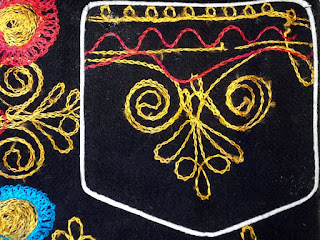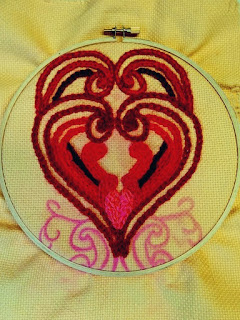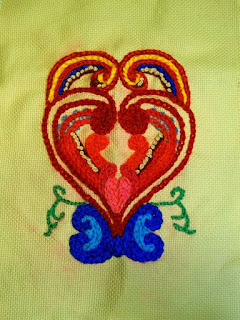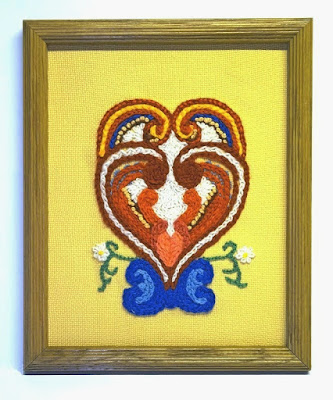(This post continues the series on crewel embroidery that Annake began in October, 2015.)
If you are a new reader of this blog, or if you haven't done any chain-stitch lately, you may want to read the previous
post about chain-stitching (October 31, 2015) before reading this one. I suggested using a firm, but loosely-woven, fabric for your practice stitches. That advice is for this series of stitches as well. The fabric does not need to be wool. In fact, some of the wool/polyester blends are preferable for our purposes. You can use other fabrics, such as decorator burlap, too, but it is important that you can pull out a single thread easily without damaging the fabric. Work with the fabric in a hoop if possible. You can also stretch fabric over an empty picture frame and use overcast stitches to hold it in place.
 |
| Pulling threads for guide rows |
In our first session, we stitched a series of plain chain-stitch samples, then embellished them with back-stitching, overcasting, couching, etc. This time we are going to do a group of variations on the plain chain itself. I strongly advise you to use the pulled-thread method to learn each variety of chain-stitch and practice each one until you can make neat, evenly-spaced stitches before you begin an embroidery project. I don't expect any of you to like all of the different stitches, but I do urge you to try each one. The first is similar to plain chain, except that the number of threads skipped with each stitch is not the same. I'm not aware of a name for this stitch, so I will call it Long-and-Short Chain.
 |
| Long-and-Short Chain stitch |
Start with a waste knot. Begin as you did for plain chain, but skip 5 threads instead of 4 to make the first stitch in the chain. Skip only 2 threads for the second stitch. Repeat the 5/2 pattern to the end of the row of stitches. Pull the short stitches tighter than the long ones, but not so tight that it pulls the fabric out of shape. You can vary this stitch pattern in many ways: 5/2/2, 5/5/2, 6/4/2, etc. Be sure you use the same grouping each time, and try to end the row with a complete group, rather than a partial one. The short stitches appear nearly round, while the longer ones are oval or teardrop-shaped.
 |
| Double Chain stitch |
Our next chain-stitch is a Double Chain. You will need a heavy yarn, floss, or perle cotton and a light one in a contrasting color. You can even use crochet cotton and plain sewing thread, but remember it needs to be yarn to qualify as genuine crewel embroidery. With the heavier strand, make a rather loose plain chain across the fabric (Row A), secure the end, and cut the strand. With the finer strand, start just outside the beginning of Row A and make a chain stitch that ends in the center of the first loop of the first stitch in Row A. The second stitch should pass over the joining of the first and second stitches of Row A and end in the center of the second stitch. Continue in this way across the row.
 |
| Zig-zag Chain stitch |
You will need two pulled-out strands that are parallel, with 4 to 6 threads separating them, for the Zigzag Chain. Begin on either open row. Instead of ending the stitch on that row, however, point your needle diagonally so that the stitch ends on the second open row. Your second stitch will begin on that row and end on the first row. Continue alternating in this way, while trying to keep your stitches the same length each time. This takes a little practice, so don't get discouraged. This stitch makes a nice border. If I am doing it on a garment or any piece that will get heavy wear, I “cheat” on this stitch. I couch each loop down with the tiniest stitch possible before bringing my needle up inside the loop to make the next stitch. This makes the row of stitches harder to snag and easier to launder and iron.
 |
| Magic Chain stitch |
Our next stitch is called Checkered Chain or Magic Chain. You will need two contrasting colors of yarn, floss, thread, etc. They should be of equal length and weight and similar in texture. Use single strands of yarn and not more than 3 strands of floss to begin with. Knot both strands together for your waste knot and thread them both into the needle. Start a beginning plain chain, but loop only Color A under the needle tip. Make sure that Color B stays on top of the needle. You may want to hold it to one side with your thumb, making sure it does not pass in front of or below the needle's tip. Pull both strands through the fabric. Only one color loop should show (Color A). For the second stitch, loop color B under the needle tip and keep Color A out of the way. Continue on in this pattern. As I come close to completing the loop, I gently pull the hidden color strand through the fabric first. Be careful to keep the strands from twisting around each other as you stitch. When you see that you will run out of one color, pull both strands through the fabric, secure them, and cut both. Start with two new strands of the same length, beginning your first stitch inside the last complete loop. This stitch can be bold or very dainty.
 |
| Cow's Head stitch |
The next stitch has a number of names, including Wheat Ear Chain, Chain and Fly Stitch, and Tete de Boeuf (Cow's Head). It can be worked either horizontally or vertically. Start at one end of your open row. Make two short, slanted stitches: one on each side of the open row, with the pair meeting in a V at the same space in the open row. Bring your needle up just inside the point of the V and make a chain stitch. Couch it down with a short stitch. You have made the first “link” in the chain. Make another V so that its point is directly below the couching stitch of that link and complete it with a couched chain stitch. The slanting lines in each V should be parallel to the slanting lines in the first V and should be the same length each time. The chain should not show any fabric between the links.
 |
| Tete de boeuf variant |
This picture shows a variation of the same stitch. Instead of two slanting stitches, start with one long straight stitch that you do not pull tight. Make your chain stitch over the straight stitch and at right angles to it. Pull the chain-stitch loop tight enough that it pulls the center of the straight stitch into a shallow V. Couch the loop with a small straight stitch. Make the next straight stitch across the end of this small couching stitch. Repeat.
 |
| Detached Cow's Head stitches |
Do you remember the Lazy Daisy Stitch from the previous lesson in this series? It was a single, couched-down chain stitch that can be used to represent flower petals or other elements of a design. The single
Tete de Boeuf (V and couched chain stitch together) can be detached in the same way. It is a good small motif for fillings and diaper patterns. (Use our Search Engine feature to find out more about diaper patterns.) I must say that these detached stitches look more like little rabbits to me than cow's heads.
Now I'm going to ask you to turn your hoop or frame ninety degrees. The Cable Chain, one of my favorites, is easiest to learn top-to-bottom. I'm going to teach you a two-handed way to make this chain, so rest your hoop against a tabletop –- or your knees. (Later you may want to try twisting the thread around your needle one-handed.) With your stitching hand, bring your needle up at the end of your pulled row. With the thumb of your other hand, pull the thread straight down and hold it. Run your needle horizontally underneath the taut thread and lift it a tiny amount. With your free hand, wrap the thread around the needle from back to front and around again. With the needle held vertically, pull the thread snug against the fabric until it covers two or three threads of fabric Insert the point of your needle just below the wrapped thread and make a chain stitch. Pull the loop to the size you want and hold the thread down with your thumb to repeat the process. This is shown in the picture of the deep purple stitches. The picture of white stitches on a blue background shows the Cable Chain worked from left to right. Keep the links the same size.
 |
| Cable Chain, horizontal |
Happy stitching,

 This post by Annake's Garden is licensed under a Creative Commons Attribution-NonCommercial-ShareAlike 3.0 Unported License.
This post by Annake's Garden is licensed under a Creative Commons Attribution-NonCommercial-ShareAlike 3.0 Unported License.




























